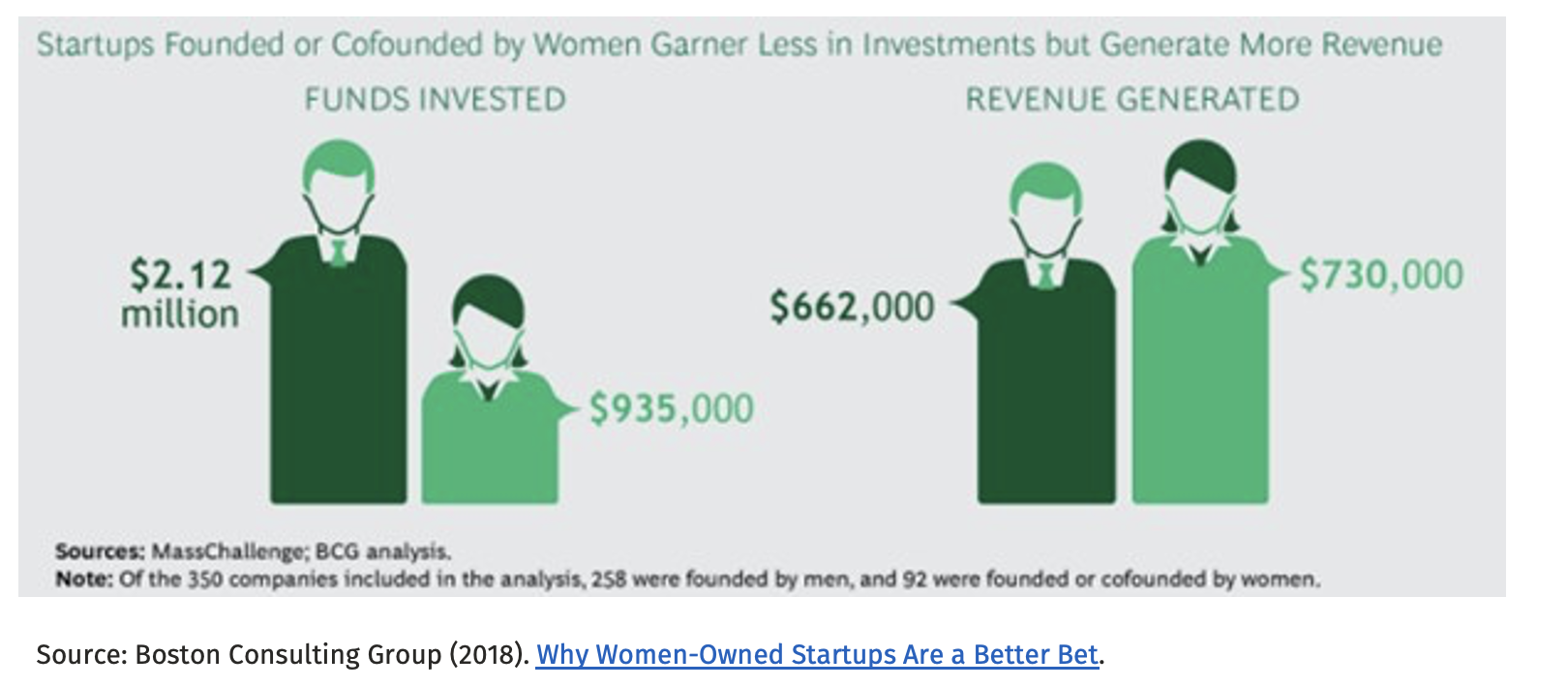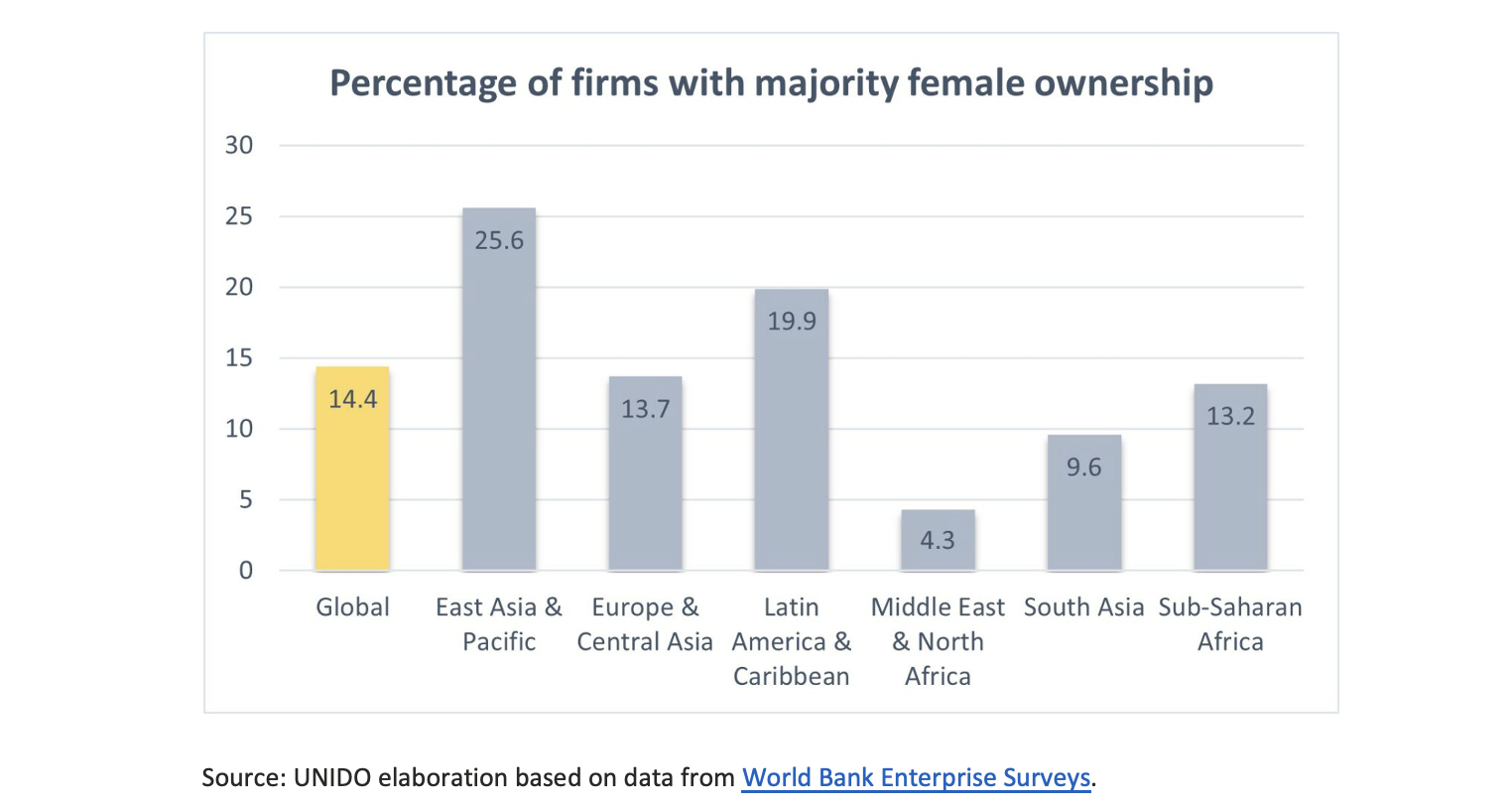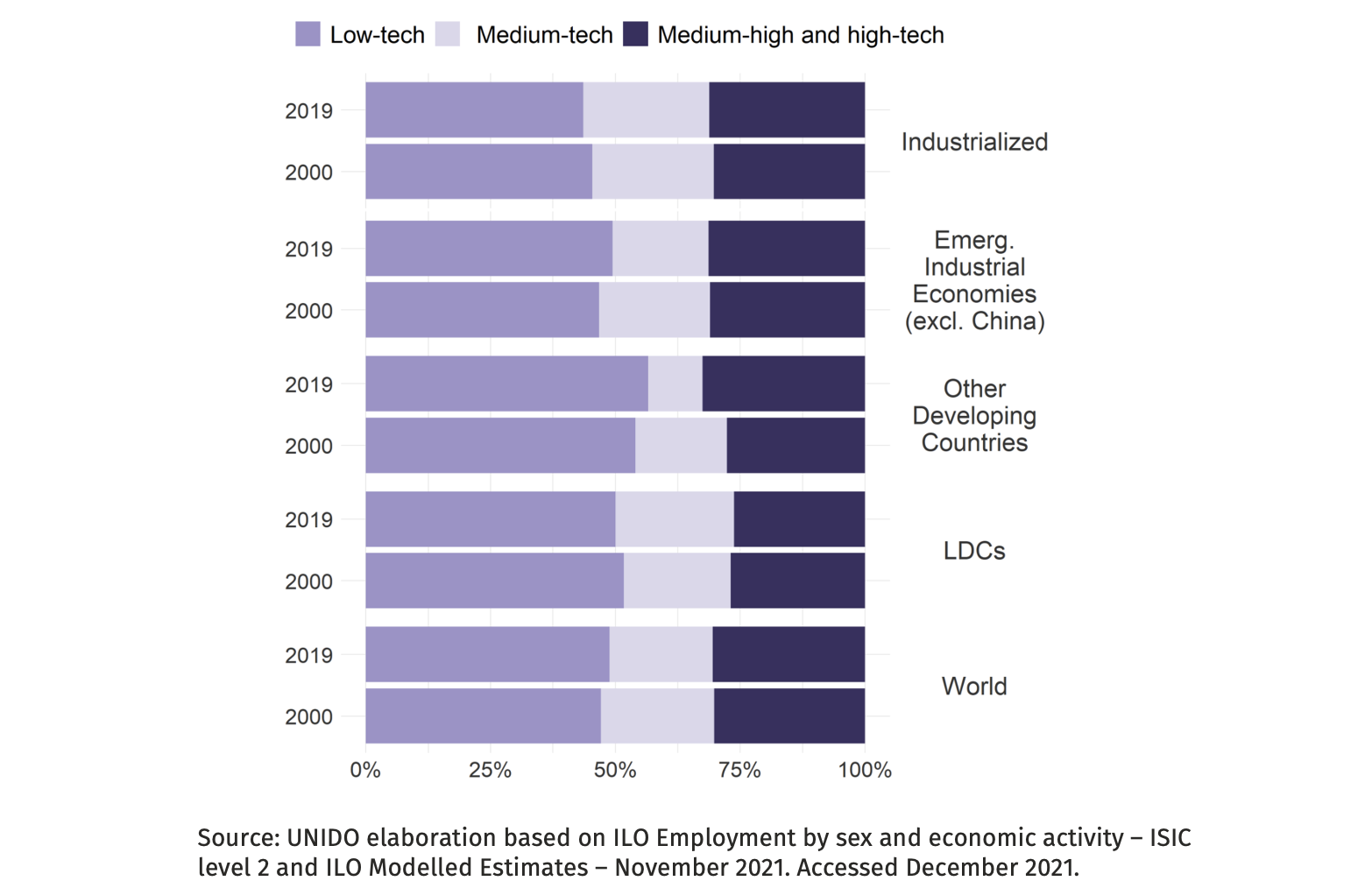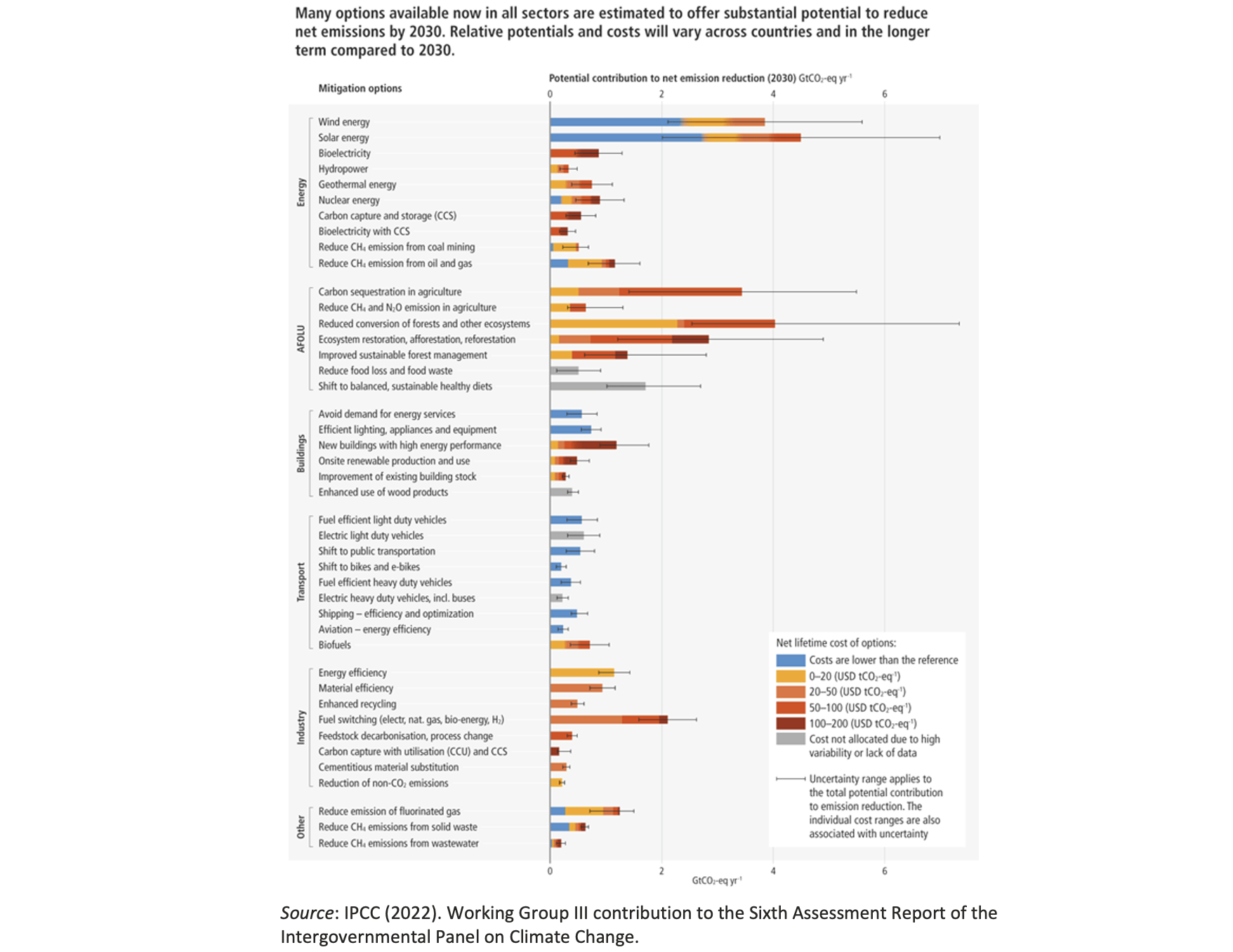By Cecilia Ugaz Estrada, Director, Gender Equality and Empowerment of Women Office, United Nations Industrial Development Organization (UNIDO) ; and Carmen Schuber, Gender Expert, Gender Equality and Empowerment of Women Office, United Nations Industrial Development Organization (UNIDO)
Originally published by UN SDG:Learn.
Women entrepreneurs are active agents of change to achieve the Sustainable Development Goals (SDGs) by 2030. Despite recent progress in strengthening women's entrepreneurship, significant differences in the number of women and men as owners and managers of microenterprises and small and medium enterprises (SMEs) persist. The broad field of research and existing lessons learned can shape present and future approaches to level the playing field for women-owned enterprises.
Strengthening women entrepreneurs is a human right, and an economic and environmental imperative
Gender disparities in entrepreneurship stem from deeply enshrined legal, socioeconomic and cultural discriminatory gender norms and practices. Men and boys as well as women and girls continue to be influenced by these gender inequalities that permeate all aspects of their daily lives. They also have a direct effect on women's business activities: The higher the level of gender equality in law in a country, the higher its share of women entrepreneurs. The same applies to the number of years of education of women, their access to bank accounts and their ability to take loans from a financial institution, which all have a positive impact on women's entrepreneurship.
Diminishing the gender pay gap and strengthening women's businesses makes economic sense. Because of differences in lifetime earnings between women and men, countries are currently losing $172 trillion in wealth. Conversely, if women were earning as much as men, human capital wealth could increase by about one fifth globally.[2] Also, a wide array of studies highlight the benefits of gender equality and diversity for the profitability and level of innovation of businesses. As the figure below illustrates, once women-led start-ups and MSMEs dispose of enough financial means, their return on investment exceeds the average.
Figure 1: Return of investments of start-ups founded or cofounded by women

Investing in women entrepreneurs is also smart for achieving social and environmental objectives. To successfully counter the climate crisis, we need to fully tap into all human potential - including that of women. Studies further suggest that women entrepreneurs show higher levels of social and environmental orientation than their male counterparts.[5] They were also found to be more likely than men to emphasize social goals over economic goals and to engage in ecological venturing.[6] In fact, across the globe, the gender gap in social entrepreneurship is significantly smaller than that in mainstream entrepreneurship, and women-led social ventures perform at least equally compared to those led by men.[7] This is in line with findings that women entrepreneurs, more often than men, focus their field of operation towards community needs or social needs.
Women-owned businesses still face specific challenges in entrepreneurship, with negative effects on firm size and profit
However, owning and managing a business remains a male-dominated territory. Globally, only less than one in five businesses have a woman as their top manager, only one in three businesses have a woman among their principal owners, and women are the sole or majority owners of less than 15% of businesses.
Figure 2: Percentage of firms with majority female ownership

Also, the larger the business, the lower the share of women-owned businesses. For example, in limited liability companies - a legal form largely used for SMEs[10] - the share of female business owners only ranges from 2% to 39%,[11] while for microenterprises with a maximum of 10 employees, the share of businesses with women as sole proprietors is significantly higher, ranging from 3% to 47% and only in two countries, women hold the majority of microenterprises.
Moreover, women-led MSMEs also dispose of less capital than businesses owned by men: Only 28% of MSMEs are owned by women, but they account for 32% of the MSME finance gap. This gender finance gap is especially pronounced in developing economies. Importantly, it also widens with the size of the business and is thus larger at the SME level than for microenterprises.
For start-ups, the situation is similar. Women-led start-ups also receive significantly less funding than their male counterparts: Globally, only 7% of venture capital is invested in women-led businesses. This disparity is neither justified by differences in the founders' profiles such as the level of education, nor by differences in profits.
SUGGESTION 1: Instead of focusing on high-growth firms, rather support women-owned SMEs in growth-oriented sectors
The significant gender differences in firm size and access to finance are both a cause for and a result of the varying representation of women across economic sectors, including industry. The more profitable a sector and the higher its average wages and profits, the fewer women business owners, managers and decision-makers can be found. As illustrated in the figure below, women entrepreneurs (and also women employees) are less likely to operate in growth-oriented and technology-intensive sectors such as computer, electronics, machinery and transport equipment. It is also no coincidence that these "non‐feminine" industries are the fastest-growing sectors with high investments and high return on investment. At the same time, women entrepreneurs are overrepresented in low-technology industrial sectors with lower profit margins such as the food, garment, textile and leather sectors, but also in service and retail.
Figure 3: Structure of female employment in manufacturing sectors by technology intensity

The fact that women-led MSMEs tend to be smaller, less profitable and grow slower than male-led firms is directly related to these sectoral disparities. For example, a long-term study of U.S.-based entrepreneurs shows that women‐owned firms in so-called "feminine" industries are less likely to achieve high growth than women‐owned firms in "non-feminine" industries.
Therefore, much speaks for strengthening measures to support market entry and business growth of women entrepreneurs into these high-growth sectors with a traditionally low representation of women. Supporting women's networks and role models has been identified as an important factor that should be prioritized in this regard. For example, a study in Ethiopia showed that these factors are a key determinant for a woman's decision in which sector to establish her business.
This approach also seems to be preferable to supporting already existing high-growth firms owned or led by women. In fact, high-growth firms have received significant attention in the last years. Making up less than one fifth of all firms in the manufacturing and service sectors while creating more than half of all new jobs and sales in high-income and developing countries alike, they indeed play an important role in strengthening economic productivity and creating ripple effects. However, women-owned/-led high-growth firms are rare. For example, in the U.S., close to 40% of high-growth firms don't even have one single woman on their boards. Also, studies show that high-growth rather seems to be a finite phase than a long-term firm characteristic, and that high-growth does not necessarily translate into high productivity.
SUGGESTION 2: When supporting women-owned SMEs, a holistic, multi-level approach is desirable
In light of the multiple and intersecting forms of gender inequality, a one-dimensional approach, even if applied in crucial areas such as women entrepreneurs' access to finance (e.g. through cash transfers, grants or facilitating affordable loans) often lacks effectiveness and sustainability. Instead, aggregating efforts, bundling services and an ecosystems approach is paramount. As gender disparities affect individual, institutional and normative spheres alike, direct support to women-owned SMEs should be coupled with strengthening women's business associations and other civil society organizations, and providing advice to the public sector in the development and implementation of policies that foster women's entrepreneurship. Efficient support to women entrepreneurs therefore also entails the need to forge multi-level partnerships - from financial institutions to business representations to regulatory and policymaking bodies.
The evaluation findings of a UNIDO project to promote women entrepreneurs and women-led SMEs in the MENA Region exemplify this by highlighting the project's holistic, multi-level approach as good practice, which has also been further intensified in the currently ongoing second phase of the project. This strategy combined facilitating gender-responsive policy reforms with capacity development of intermediate institutions such as women business associations, and providing targeted support to women entrepreneurs in three main areas: capacity building on business development and management, strengthening access to networks and market platforms, and providing financial support.
In practice, however, limited resources often affect the scope of support to strengthening women entrepreneurs. Sometimes, stakeholders are faced with the need to choose between focusing on one set of measures applied across several sectors and subsectors, or providing a broad range of measures within one value chain. From the aforementioned research and evaluation findings that highlight the good practice of providing holistic support, it can be deduced that of the two options, providing a broad range of measures within one value chain would be the preferable one.
SUGGESTION 3: In countering the climate crisis, strengthening women-owned SMEs is both the right and the smart thing to do
Efforts to make gender equality in entrepreneurship a lived reality must be guided by countering climate change - the most important global systemic threat for the global economy. The message of the Intergovernmental Panel on Climate Change's (IPCC) most recent sixth assessment report, is clear: Some impacts of the climate crisis are already irreversible, even if global warming will be reduced in the future. Global efforts to counter climate change need to urgently and significantly increase to avoid further permanent harm.
The link between female entrepreneurship and fostering more inclusive, green and smart growth has often been underappreciated. In fact, women seem to be more attracted to green industries than to traditional ones. For example, the share of women in the renewable energy sector workforce is higher than that in the fossil fuel sector, notably 32% compared to 22%. Also, UNIDO research suggests that women entrepreneurs are more inclined to set up and expand their businesses in green industries than in conventional industries.
Priority should also be given to initiatives that support women entrepreneurs with a promising business approach that contributes to achieving climate goals. As detailed in the figure below, energy, industry, forestry, transportation and agriculture are the sectors with the highest potential to reduce greenhouse gas emissions, with much of this potential being at the supply side. For the industrial sector, reaching net-zero CO2 emissions by 2030 requires bold and concerted actions across all mitigation options, including energy and materials efficiency, circular material flows, and transformational changes in production processes.
Figure 4: Potential contribution to net emission reduction by sector

Moreover, the shift to energy sustainability and circular economy is estimated to generate a gross amount of over 100 million jobs and a net amount of 20 million jobs by 2030, but the majority of these new jobs will be created in male-dominated sectors.[31] Hence, in order for women to equally benefit from the shift to green economies and industries, specific measures to reduce gender inequalities and empower women in these sectors and industries are needed.
Women-owned MSMEs constitute a huge potential for innovation, growth, and reducing the impact of climate change and environmental degradation. To advance progress towards net-zero, climate-neutral and green industries and economies, we therefore need to fully tap into women's abilities as entrepreneurs, managers and innovators.
* Cecilia Ugaz Estrada is Director of Gender Equality and Empowerment of Women Office and Special Advisor, Office of the Managing Director, Directorate of Corporate Management and Operations, UNIDO. She formerly was Director of the Policy Research and Statistics Department at UNIDO. Cecilia holds a PhD in economics from Ecole des Hautes Etudes en Sciences Sociales in Paris (major: Econometrics of Investment) as well as graduate degrees in economic modelling from France and Peru. Prior to joining UNIDO, she served as United Nations Resident Coordinator and UNDP Resident Representative for Paraguay, as Deputy Resident Representative for UNDP in Argentina and as Deputy Director of the UNDP Human Development Report Office. Cecilia Ugaz Estrada also held various positions with the United Nations and in academia in Switzerland, United Kingdom and Finland as well as with the World Bank in Washington DC.
* Carmen Schuber is Gender Expert at UNIDO, working on policy, capacity building and programmatic support in the intersection of gender equality and sustainable industrial development. Prior to joining UNIDO, she was Gender and Law Specialist at the International Development Law Organization (IDLO). Carmen held various specialist-level positions at UN Women with programme management, coordination and partnerships responsibilities. This included positions in the Office of the Executive Director, the Secretariat of the UN Secretary-General's High-Level Panel on Women's Economic Empowerment, and the UN Women Country Offices Sierra Leone and Cameroon. Carmen has a postgraduate degree in law and more than ten years of work experience with international organizations.






